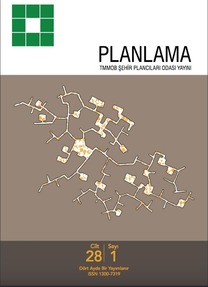Kent Planlama ve Kentsel Altyapı İlişkisinin Evrimi
Evolution of the Relationship between Urban Planning and Urban Infrastructure
___
- Amekudzi, A. A., Thomas-Mobley, L., & Ross, C. (2007). Transportation Planning and Infrastructure Delivery in Major Cities and Megacities. Transportation Research Record: Journal of the Transportation Research Board, 1997(1997), 17–23. https://doi.org/10.3141/1997-03
- Benovolo, L. (1992). History of the City. In S. Kostof (Ed.), The City Assembled: Elements of Urban Form through History. Boston MA: Little, Borwn and Company.
- Davidoff, P. (2011). Advocacy and Pluralism in Planning. Journal of the American Institute of planners, 1965. The City Reader, 5(March 2012), 435–445. https://doi.org/10.1080/01944366508978187
- Demuzere, M., Orru, K., Heidrich, O., Olazabal, E., Geneletti, D., Orru, H., … Faehnle, M. (2014). Mitigating and adapting to climate change: Multi-functional and multi-scale assessment of green urban infrastructure. Journal of Environmental Management, 146, 107–115. https://doi. org/10.1016/j.jenvman.2014.07.025
- Devlet Planlama Teşkilatı (DPT). (1982). Türkiye’de yerleşme merkezlerinin kademelenmesi: Ülke yerleşme merkezleri sistemi. Ankara.
- Dodson, J. (2009). The ‘Infrastructure Turn’ in Australian Metropolitan Spatial Planning. International Planning Studies, 14(2), 109–123. https:// doi.org/10.1080/13563470903021100
- Ertan, K. A. (2004). 20.Yüzyıl Kent Ütopyaları. Çağdaş Yerel Yönetimler, 13(3), 5–21. Retrieved from http://www.todaie.edu.tr/resimler/ ekler/3e3116a8027ba9c_ek.pdf?dergi=Cagdas Yerel Yonetimler Dergisi
- Krueckberg, N. (1989). Introduction to Planning History in the United States Title. In S. K. Schultz (Ed.), Constructing Urban Culture: American Cities and City Planning 1800-1920. Philadelphia: Temple University.
- Neuman, M. (2007). Multi-scalar large institutional networks in regional planning. Planning Theory and Practice, 8(3), 319–344. https://doi. org/10.1080/14649350701514645
- Neuman, M. (2009). Spatial planning leadership by infrastructure: An American view. International Planning Studies, 14(2), 201–217. https://doi. org/10.1080/13563470903021241
- Neuman, M., & Smith, S. (2010). City planning and infrastructure: Once and future partners. Journal of Planning History, 9(1), 21–42. https://doi. org/10.1177/1538513209355373
- Newman, P. (2009). Markets, experts and depoliticizing decisions on major infrastructure. Urban Research & Practice, 2(2), 158–168. https://doi. org/10.1080/17535060902979063
- Peterson, J. A. (2003). The Birth of City Planning in the United States 18401917. JHU Press.
- Schuler, R. E. (1992). Transportation and Telecommunications Networks: Planning Urban Infrastructure for the 21st Century. Urban Studies, 29(2), 297–310. https://doi.org/10.1080/00420989220080331
- Shwayri, S. T. (2013). A Model Korean Ubiquitous Eco-City? The Politics of Making Songdo. Journal of Urban Technology, 20(1), 39–55. https:// doi.org/10.1080/10630732.2012.735409
- Ward, S. V. (Stephen V. (1992). The Garden city : past, present, and future. E & FN Spon.
- Yokohari, M., Takeuchi, K., Watanabe, T., & Yokota, S. (2008). Beyond greenbelts and zoning: A new planning concept for the environment of asian mega-cities. In Urban Ecology: An International Perspective on the Interaction Between Humans and Nature (Vol. 47, pp. 783–796). Elsevier. https://doi.org/10.1007/978-0-387-73412-5_50
- Young, D., & Keil, R. (2010). Reconnecting the disconnected: The politics of infrastructure in the in-between city. Cities, 27(2), 87–95. https://doi. org/10.1016/J.CITIES.2009.10.002
- ISSN: 1300-7319
- Yayın Aralığı: 3
- Başlangıç: 1986
- Yayıncı: TMMOB Şehir Plancıları Odası
Bölgesel Gelişmişlik Düzeyinin Belirlenmesine İlişkin Veri Seti Sorunsalı: Eleştiri ve Öneriler
Sinem Dedeoğlu ÖZKAN, Dilek BEYAZLI
Gizem AKSÜMER, Mehmet Hakan YÜCEL
Türk Otomotiv Endüstrisinde Dayanıklılık, Perçin Etkisi ve Üretim Zincirlerinin Değişen Coğrafyası
Kent Planlama ve Kentsel Altyapı İlişkisinin Evrimi
Ali Kemal ÇINAR, Mehmet PENPECİOĞLU
Kent Hakkının Maddi Olmayan Boyutları: Kentsel Dönüşüm Sürecindeki İstanbul Derbent Mahallesi Örneği
Kültürel Peyzajların Tarihsel Süreç İçerisindeki Değişimlerinin Tespiti: Bursa İznik Örneği
